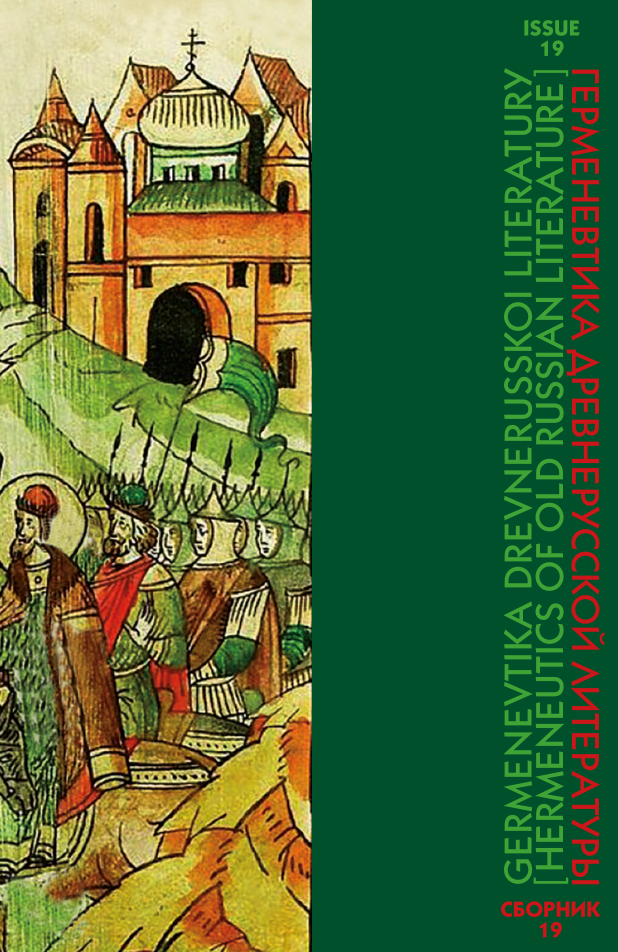|
LjustrovM.Yu. |
P. 5 |
- LITERARY CREATIVITY OF THE11TH–15THCENTURIES
LITERARY CREATIVITY AND IDEOLOGICAL ACTIVITIES OF THE 15TH – 16THCENTURIES
|
Rogachevskaya E.B. |
P. 252–261 |
|
|
Filyushkin A.I. |
Model of the “Kingdom” in the Russian Medieval Literacy of the 15th –16th Centuries. |
P. 262–279 |
|
Karavashkin A.V. |
Historiosophyand Ways of Embodying the Author’s Position |
P. 280–326 |
|
Filyushkin A.I. |
Letters of Novgorod Archbishop Theodosius, Dedicated to the “Siege of Kazan” |
P. 327–346 |
|
Mineeva S.V. |
P. 347–359 |
|
|
Olshevskaya V.A., Travnikov S.N. |
P. 360–365 |
|
|
Bahturina R.V. |
Cosmography in the Russian Edition of the 16th century (Sources and Composition) |
P. 366–383 |
|
Bryusova V.G. |
Icon “Sophia the Wisdom of God” in Novgorod Translation and Word of Wisdom |
P. 384–395 |
LITERARY CREATIVITY AND SPIRITUAL CULTURE OFTHE17TH CENTURY
|
Korotchenko M.A. |
The Influence of the Works of Joseph of Volotskon Historical Talesof the Time of Troubles |
P. 396–428 |
|
Chumicheva O.V. |
“All mental vision is a vision” |
P. 429–446 |
|
LjustrovM.Yu. |
The Departure of Patriarch Nikon as an Imitation of Samples |
P. 447–459 |
|
Andreev I.L. |
“A Reliable Hunter” (On the Question of the Place and Role of the Service in the 17th Century) |
P. 460–474 |
|
Mendeleeva D.S. |
P. 475–481 |
|
|
Pozhidaeva G.A. |
From the History of the Non-OctoechosChant of the 17th Century |
P. 482–516 |
|
ChernayaL.A. |
The Perception of Space and Time in the Russian Culture of the 17th Century. |
P. 517–528 |
CALENDAR – MATHEMATICAL LITERACY OF THE 14TH – 17TH CENTURIES
|
Simonov R.A. |
Reminiscences Teachings by Kirik in the Old Russian Literacy |
P. 529–550 |
TRADITIONS OF OLD RUSSIAN LITERATURE IN THE 18TH – 19TH CENTURIES
|
LjustrovM.Yu. |
P. 551–562 |
|
|
Yuhimenko E.M. |
P. 563–615 |
|
|
Pautkin A.A. |
The Tale of Igor’s Campaignin the Historical Narration by G. Senkevich |
P. 616–624 |
|
Vorontsova A.V. |
The Peculiarity of Manuscript Collections of the 18th –19th Centuries. |
P. 625–628 |
TRANSLATION QUESTIONS
|
Gladkova O.V. |
The Life of Saint Eustace: Byzantine Text and Slavic-Russian Translation |
P. 629–643 |
|
Schegoleva L.I., Matveenko V.A. |
Chronicleof Georgethe Monk |
P. 644–717 |
|
Grebenyuk V.P. |
P. 718–719 |
|
|
Mendeleeva D.S. |
Index of Articles Published in Hermeneutics of Old Russian Literature. |
P. 720–729 |
|
Chronicle of the Meetings of the Society of Researchers of Old Russia |
P. 730–733 |





